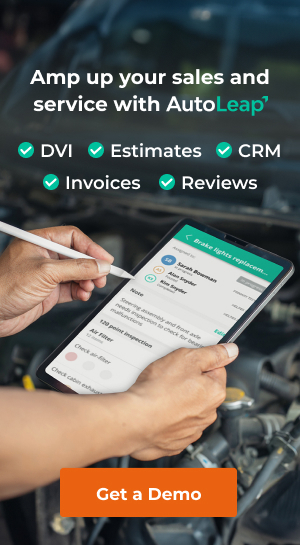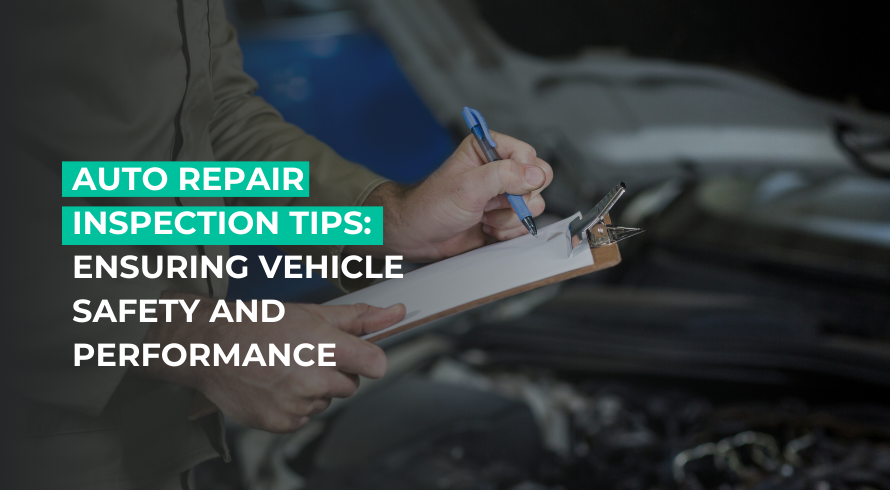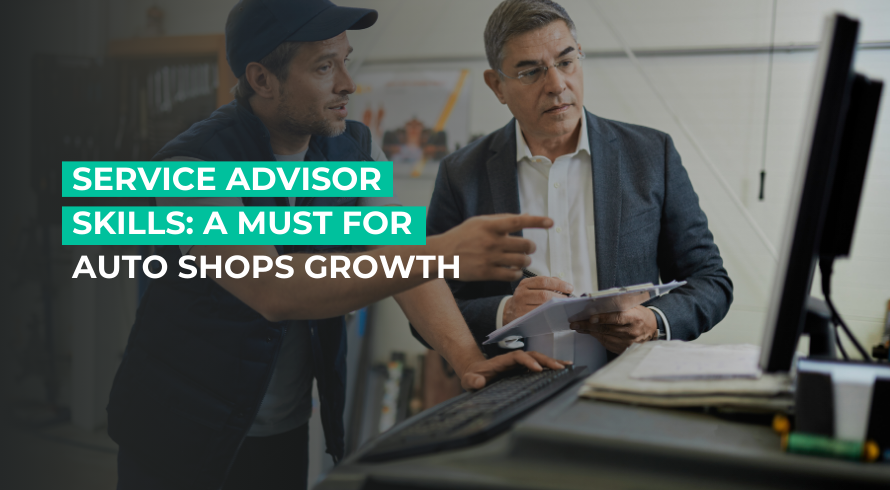Millennials (Gen-Y) and the younger generation (Gen-Z) (ages 10 to 41) will soon be your most extensive customer base, so it’s crucial to capture their attention and cater to this audience.
» Want to grow your auto repair business? Click here to schedule a demo.
O’Neal says, “This new generation is tough, savvy, and sometimes know more about their car than we do!” He claims that traditional operating methods in auto repair shops need to be replaced to keep up with the new generation. “The old school way of writing the customer up and calling them 5–6 hours later with a dissertation is not in alignment with what today’s consumers want.”
Further, O’Neal talks about how he purchased a run-down shop in 2016 and made it a million-dollar business over time while spending less than $500/month on marketing. This success was due to a change in his mindset. “Make customers want to buy what you’re offering instead of making them feel like they’re being sold.” Thanks to this ideology, O’Neal gained more organic reviews. With this information, he set up a checklist of the “anatomy of a 5-star experience” for an auto repair shop.
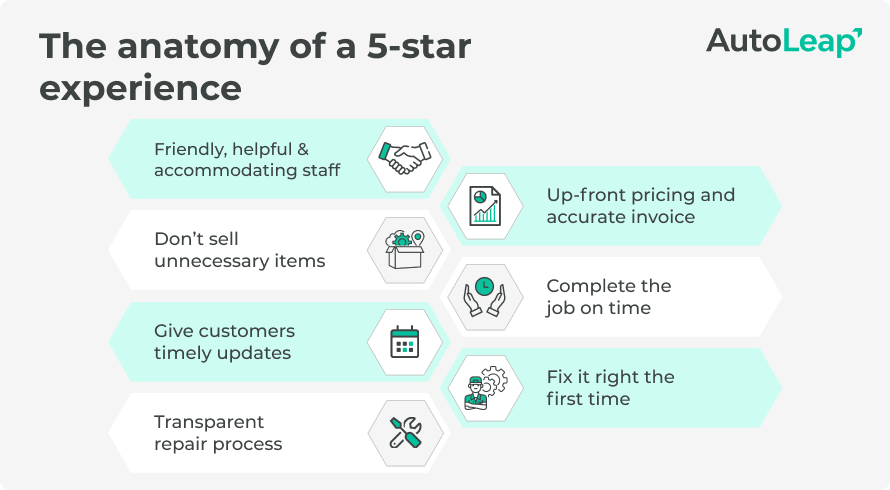
In this article, we’ll go over some of the elements that can help you deliver a 5-star experience at your auto repair shop to generation Y and Z customers.
1. Friendly, helpful, and accommodating staff
Your first interaction with a customer decides your relationship with them. “Whenever a customer calls, your first response needs to be positive,” O’Neal says.
If a customer calls in asking about the price of a water pump, your first response should be, “Sure, we’d be happy to help you with this.” A positive response puts a customer’s mind at ease and lets them know they’re dealing with someone that cares about them. If your reply is, “Sorry, we don’t give pricing over the phone,” O’Neal recommends shutting your shop and getting out of the business.
He adds, “…customers value time more than they value money.” Due to this, it’s important to be up-front and honest with your customers. There will be times when you have to deal with unhappy customers at your shop, so prepare to deal with them professionally.
2. Don’t sell unnecessary items
Customers that have a negative experience at a shop or a dealership often have one major complaint—the shop tried to sell them a service that the customer felt they didn’t need.
“We, as an industry, have conditioned people to say ‘No’ to the big R—Recommendation,” says O’Neal, and he encourages all shops to take the word out of their vocabulary. Instead, replace it with “concern” since it impacts your customers differently.
Instead of telling customers what jobs you recommend for their cars, inform them that you’re concerned about things failing and potentially further damaging their cars. The difference in tone has two significant effects on the customer:
- The customer feels like you care: Empathy will go a long way in helping increase customer satisfaction at your shop. When customers feel like you care, they’re more likely to trust what you say.
- Customers are likely to trust you long-term: Expressing concern over a customer’s car shows them that you’re looking out for their long-term needs, letting them know they can trust you with their vehicle. This is a major achievement for any auto repair shop.
It’s not just the customer that suffers when they’re sold something they don’t need; your techs also have to pay the price. O’Neal argues that investing an hour of your techs’ time into something the customer never even wanted isn’t a productive use of their time, and it’s much better to avoid that scenario entirely.
Here are some ways to improve the process for customers at your auto repair shop:
Improve your initial write-up process
Your write-up process can make or break your customers’ trust. If you get it right, it can keep customers returning to your shop.
Step 1: Set clear expectations with your customers
Managing your customer’s expectations is a crucial aspect of business dealing, along with making sure you have permission to conduct any job needed. Having your technicians spend an hour working on an inspection the customer didn’t approve of isn’t a productive use of their time.
Step 2: Do an initial walk-around
“Perform an initial walk-around for every first-time customer and repeat customers that haven’t been to your shop in 6 months,” says O’Neal. This is an extra step to show customers that you care about their cars and make an emotional connection. The sale isn’t important here—it’s about the relationship.
Today’s customers are well informed about their vehicles, so it’s important they know you are being honest and upfront with them. Here are a few steps to help you do just that:
- Link repairs to initial customer concerns: Customers should know that you care about them. If you can link all of the recommendations with your customer’s concerns, you’ll have a much higher chance of closing the deal.
- Provide a vehicle health-check report: Make sure the customer isn’t blindsided by any information that could go their way—this could be a digital vehicle inspection (DVI), an email, or any text they may get.
- Present estimates for repairs: Money is always talked about upfront. Make sure your customer knows the ballpark for the job and isn’t surprised by the number.
- Deliver results on time: Remember to deliver real-time targets. You don’t want to promise that job will be done by noon only to fail to deliver at the time. That’s the fastest way to ruin a 5-star experience.
- Contact customers on their preferred method of contact: Some customers might prefer to see their car in person to keep updated on a repair job. In contrast, others would prefer a call or an email. Make sure you talk to your customer and know what they prefer.
- Review the vehicle service history: Conducting several repairs can sometimes cause the vehicle to fall out of factory scheduled maintenance—taking the car to the shop means you won’t be able to take it to the dealership. Make sure you check the vehicle service history to ensure there are no conflicts.
Step 3: Know your customers’ vehicle ownership timeline
When a customer comes in, make sure you ask them two questions during the initial write-up:
- ‘How long have you owned the vehicle?’
- ‘How long do you plan on keeping this vehicle?’
The answer to these questions will give you an idea of where the vehicle stands in the life cycle, and you can use this to help make the best decision for the vehicle.
“I never understood why customers wait until the last 10% of their vehicle’s life to get $2000–4000 worth of work done only to sell the vehicle a few months later,” says O’Neal. “I try to get this work done in the middle of the timeline so that the customer gets the most out of their vehicle.”
3. Give your customers timely updates
It’s never a pleasant experience to have your phones constantly ring with customers asking the same question repeatedly. This can be efficiently dealt with by sending your customers automated messages at every step of the process. Using automotive repair software can help make this process a lot easier.
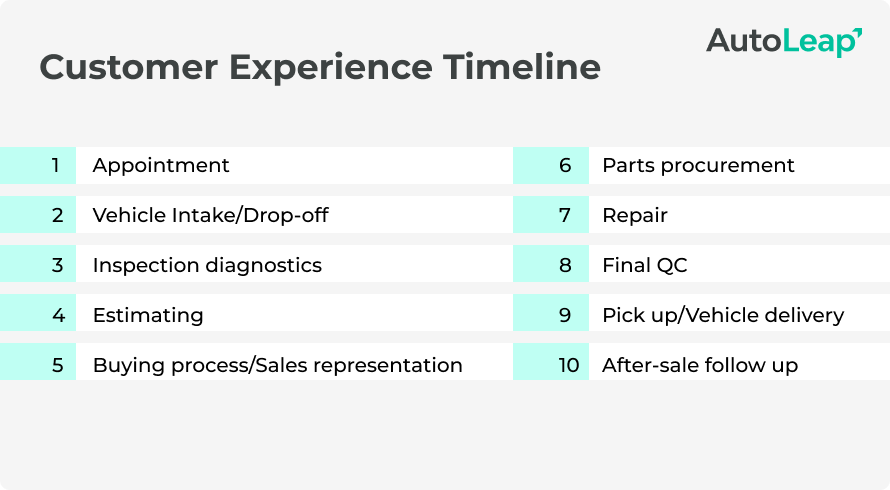
Responding to an automated text message is much better than getting a phone call for both you and your customers. Remember to do proper quality control on these texts—a few things to look out for could be:
- Timing of the text: Make sure that you send your texts when customers appreciate the follow-up. It could reflect poorly on you if the texts go out at 3 AM when you likely won’t get a response but might get an annoyed customer.
- Giving relevant information: The body of the text should have any important information that the customer needs to know, such as the current stage of their vehicle’s repair process. Messages should still be short and to the point so that recipients don’t have to take out too much time to read them.
- A non-robotic tone: Your text should sound human, not like a robot trying to sound like a human. On the back-end of your software, make sure the tone of your text is inviting and makes the customer feel at ease. Saying phrases like “Your car is happy you chose us!”, “Our team is hard at work to give you a 5-Star experience”, and “Feel free to contact us if you have any information.”
- Contact information: Customers will need your contact information if they have any concerns about the job or want more information. Make sure the body of the text includes your contact information at the very end.
Proactive communication
The younger generation loves quick responses, and you can’t achieve that efficiently through telephone conversations; there are only so many calls you can handle at once.
Having an effective social media presence will help you reach a wider audience much faster, giving your customers that quick response they’re looking for. O’Neal says, “If you don’t have a way to communicate with your customers without a telephone, you’re missing a huge part of communication today.”
10/12/3 rule
To help with making sure your process stays as efficient as possible, O’Neal lays out a time plan he calls the 10/12/3 rule. This time management routine will help you stay on top of your tasks and ensure updates get sent promptly.
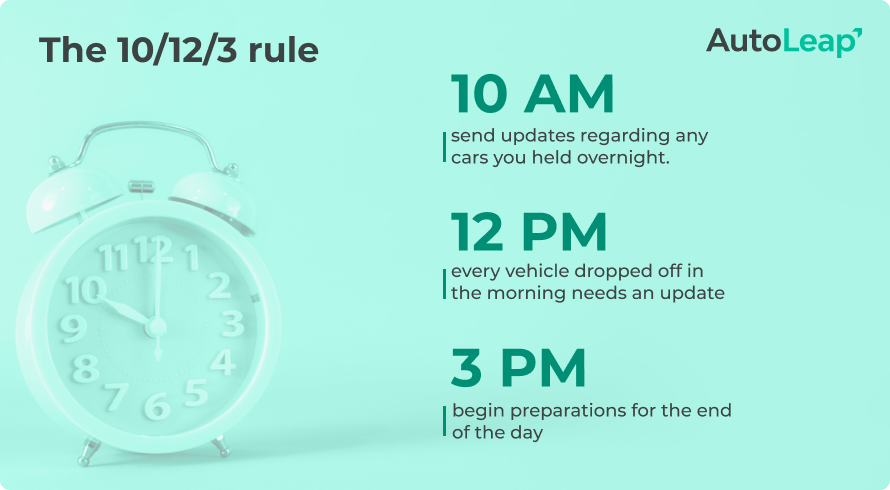
4. Transparent repair process
Building trust with your customer is one of the best things you can do as a shop owner. Being transparent about your repair process is an excellent way to do just that.
By taking advantage of modern technological advancements in auto repair, such as digital vehicle inspections, you can keep your customer in the loop regarding their vehicle’s condition at each step of the repair process. Attaching pictures, videos, voice memos, and comments to an inspection will let the customer see the exact fault in the vehicle and assure them that they aren’t being charged for an unnecessary repair job.
However, it’s essential to make sure the customer also knows how to navigate the application that you’re using.
5. Up-front pricing and accurate invoice
When giving your customers pricing information, it’s best to take an up-front and no-nonsense approach. Let the customer know exactly how much the job will cost and be transparent about the specifics in your invoice.
Providing customers with prices inclusive of taxes can be a good way to align expectations.
6. Complete the job on time
When giving your customers a deadline for vehicle pick-up, make sure the vehicle is ready at the agreed-upon time; otherwise, you’ll leave a bad impression. To delay a vehicle beyond the original date is, as O’Neal puts it, “The kiss of death, and nothing takes you off a 5-star experience faster than that.”
7. Fix it right the first time
Customers don’t want to come back to the shop every few months to fix an issue that will persist every few months. A correct initial diagnosis will not only greatly help build customer trust but will also:
- Save your technicians time: Techs won’t spend their time working on more minor issues to simply patch the problem but will fix the root cause. This will free up time for them to take on other jobs and increase your overall average repair order size.
- Boost your shop’s reputation: Would you take your car to a shop known for fixing the issue on the first visit or a shop known for having customers come back every few months? The former is much more attractive and is what many will lean towards.
Closing thoughts
O’Neal says that when you think of marketing to the younger generation, you need to let go of conventional business tactics and adopt an approach centered around making the customer feel like you genuinely care about their vehicle. You need to be up-front, transparent, and remember that in some cases, the customer might have more knowledge about their vehicle than you would expect. You need to get the job done right and quickly if you want your business to succeed.


